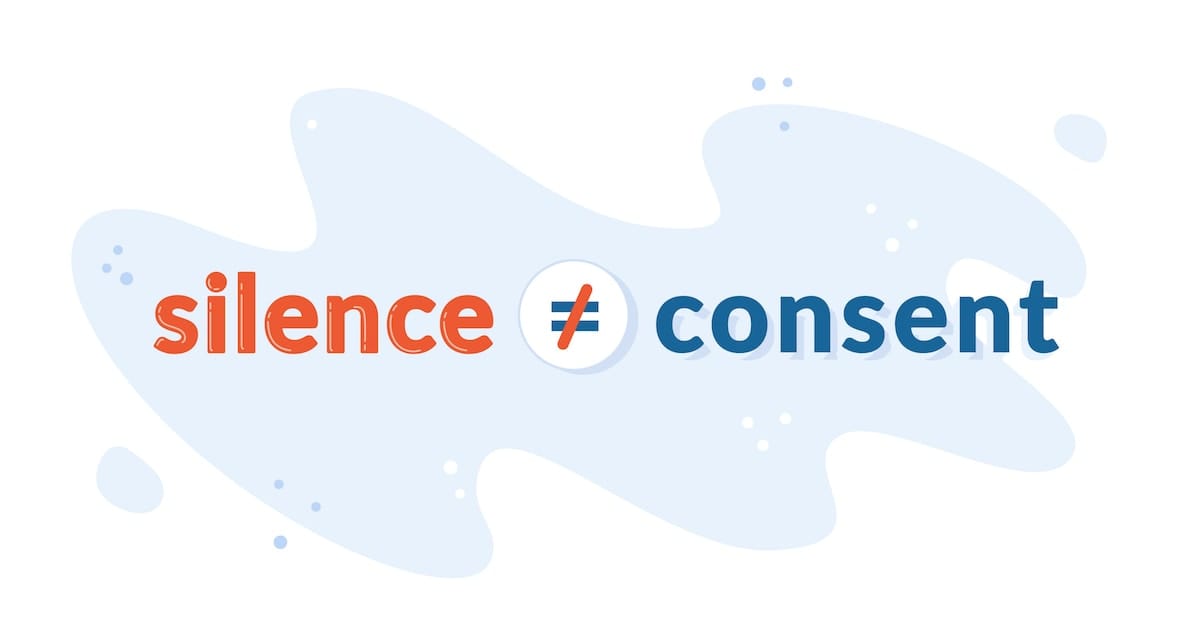The #MeToo movement has helped bring to light how prevalent sexual assault is (and has been) in America. At the same time, the movement is helping people become aware that consent is absolutely necessary to ethically and legally have sex. Many people are still not entirely aware of what consent entails, or what constitutes sexual assault.
A warning before we begin: The content of this guide discusses sensitive topics, and may be triggering for victims of sexual assault or rape.
The Definition of Consent
Sexual consent, at the base level, is communicating agreement to have sex. It can be withdrawn at any time, and previously giving consent does not guarantee future consent, even for the same action. The definition of consent is giving permission or agreement in no uncertain terms.
It’s more than just saying “yes.” For someone to be able to give voluntary informed consent to sex, they must be of legal age to have sex, they must not be coerced into agreeing, and they must be conscious.
Consent also stands contrary to sexual deceit. In short, a person is giving consent to an expected situation. Consenting to have sex with someone, only to discover it is actually the person’s twin, is not actually giving consent.
When Is Sexual Activity Consensual?
Sexual activity is only completely consensual when consent continues throughout the sexual act, and both parties have the legal capacity to give consent. If either party says “no” at any point, revoking or withdrawing their consent, then the activity is no longer considered consensual.
In order to obtain informed consent, communication is vital. Be thorough, and have all the information possible before saying “yes.”
Is There an Age of Consent in the US?
Consent is not simply a moral discussion, but a legal one as well. The age of consent is a factor in statutory rape, and age of sexual consent is under state jurisdiction. The age of consent by state varies, ranging from 16 to 18. More than half of the states recognize 16 as the age of consent.
In most cases, if an adult has sex with a minor under the age of consent, it counts as statutory rape. While there are close-in-age exemptions, often called Romeo and Juliet laws, these also vary by state. In California, for example, the age of consent (18) is a hard line, and two 17-year-olds having consensual sex have both committed a misdemeanor.

Is Silence Consent?
Under no circumstances is silence considered consent. A sexual partner must give verbal consent, or body language must explicitly indicate consent. You must be careful when relying on physical cues, especially if alcohol is involved, as these non-verbal cues could be incorrectly interpreted.
Verbal consent, assuming the person is not impaired, is always best. If the person is impaired, they may remain silent or say yes, but are actually unable to give true, informed consent.
What You Should Know about Consensual Sex
Consensual sex, as mentioned earlier, is about communication. Planned Parenthood describes consensual sex with the acronym FRIES:
- Freely given: There is no pressure or manipulation from either party, nor the influence of drugs or alcohol;
- Reversible: Consent can be withdrawn at any time, even in the middle of sex;
- Informed: All parties have all the information about what is happening, and there is no sexual deceit. This includes talking about birth control, such as condoms, and if either party has any STDs before engaging in sex, and what the chances are of contracting any STDs even if no symptoms are present. Remember that talking about STDs prior to sexual contact can keep a sexual encounter from becoming non-consensual. New information — like discovering your sexual partner has an STD or STI — can change the situation.
- Enthusiastic: You only do what you want to do, not what is expected of you.
- Specific: You have said yes to something specific, and saying yes to one act does not mean giving consent to other acts, even if you have consented before.
It’s important that all parties are honest with each other. Whether it’s specific acts someone does or does not want to do, or whether someone has STDs, it’s important to have all the facts and make an informed decision on whether to give consent or not and thus engage in sex.
Consent is never implied. Even if you have consented before does not mean you automatically are giving consent again. Past behavior, the clothes you are wearing, or how you act does not imply consent; you can only give consent by clearly communicating it.
It does not matter if this is the first time you are having sex with a partner, or you have been together for years; each and every time you engage in sex, consent is required. You can tell other parties to stop at any time. You get final say in what happens to your body, and can withdraw your consent at any time; you don’t have to give a reason.
If you are unsure whether the other party is ok with what’s happening, simply ask them. If they say “no,” immediately stop whatever you are doing.

The Definition of Sexual Assault
It’s important to know what counts as sexual assault in order to prevent it. According to the Office of Women’s Health, sexual assault is “any type of sexual activity or contact that you do not consent to.” This includes, but is not limited to, rape, sexual abuse, or any form of unwanted sexual behavior to which a person does not consent. It could be a touch, or unwanted sexual remarks.
What is the Definition of Rape?
The Department of Justice defines rape as: “The penetration, no matter how slight, of the vagina or anus with any body part or object, or oral penetration by a sex organ of another person, without the consent of the victim.”
It’s extremely important to know whether there’s consent given in any situation in order to avoid rape. For example, if someone is incapacitated but conscious, they cannot give consent. Incapacitation is often associated with alcohol, and follows impairment and intoxication. Impairment is considered “under the influence” while intoxication is popularly called being “drunk.” Incapacitation is only followed by overdose.
In many cases, especially those in college settings, incapacitation is associated with alcohol and alcohol abuse, leading to incapacitation rape, as one person cannot consent.
What is Sexual Harassment?
Sexual harassment, as defined by the Equal Employment Opportunity Commission, includes “unwelcome sexual advances, requests for sexual favors, and other verbal or physical harassment of a sexual nature.”
The harassment itself does not have to be sexual in nature; for example, disparaging remarks about women as a whole are considered sexual harassment.
The Rape, Abuse, and Incest National Network provides a list of sexual harassment examples:
- Making conditions of employment or advancement dependent on sexual favors, either explicitly or implicitly;
- Physical acts of sexual assault;
- Requests for sexual favors;
- Verbal harassment of a sexual nature, including jokes referring to sexual acts or sexual orientation;
- Unwanted touching or physical contact;
- Unwelcome sexual advances;
- Discussing sexual relations/stories/fantasies at work, school, or in other inappropriate places;
- Feeling pressured to engage with someone sexually;
- Exposing oneself or performing sexual acts on oneself;
- Unwanted sexually explicit photos, emails, or text messages.
These actions can come from managers, coworkers, colleagues, peers, teachers, and anyone you engage throughout your day-to-day life.
What is Sexual Abuse?
The American Psychological Association defines sexual abuse as “unwanted sexual activity, with perpetrators using force, making threats or taking advantage of victims not able to give consent.” They also note that most victims and perpetrators know each other.
Child sexual abuse, also called child molestation, describes acts committed against minors. Marshall University’s Women’s Center explains that the abuse “can be physical, verbal or emotional and includes such acts as sexual touching, exposing the child to pornography, taking pornographic pictures of the child, ‘peeping’ at the child, exposing oneself to a child, and attempting/performing oral, anal, or vaginal penetration.” Statutory rape falls under this category.
Sexual Assault Facts
In the U.S., the CDC found about 1 in 3 women and nearly 1 in 6 men experienced some form of contact sexual violence during their lifetime. The CDC also found that:
- About 1 in 5 women, an estimated 23 million women in 2012, have experienced completed or attempted rape at some point in their lives.
- About 1.5 percent of men, or about 1.69 million men, will experience attempted or completed rape in their lifetime. About 1.7 percent of men will be made to penetrate someone else against their will.
- Nearly 1 in 3 U.S. women and 1 in 8 men have had non-contact unwanted sexual experiences in their lifetime.
- Contact sexual violence, physical violence, and/or stalking by an intimate partner was experienced by more than a third of women during their lifetime.
- A third of female rape victims were between 11 and 17 years old when they first experienced sexual assault.
- 1 in 8 female rape victims reported sexual assault occurred before age 10.
- Nearly 1 in 4 male rape victims were between 11 and 17 years old when they first experienced sexual assault.
- About a quarter of male rape victims reported sexual assault occurred before age 10.
- Besides the emotional and mental toll to victims of sexual assault, the estimated the cost of rape in 2019 was $122,461 per victim, including medical costs, lost productivity, criminal justice activities, and other costs.

What You Should Know about Preventing Sexual Assault
There are certain risk factors and sexual assault prevention measures that everybody should be aware of. It’s important to believe and empower victims when and if they make their assault known.
Identify Risk Factors
The CDC, as part of their STOP SV package, noted there are a number of risk factors at both the personal and societal level that increase the likelihood of sexual assault:
- A history of child physical abuse;
- Exposure to parental violence;
- Involvement in delinquent behavior;
- Acceptance of violence;
- Hyper-masculinity;
- Traditional gender role norms;
- Excessive alcohol use;
- Early sexual initiation and sexual risk-taking behavior (such as sex without a condom);
- Association with sexually-aggressive peer groups;
- Poverty or low socioeconomic status;
- Gender inequality;
- Exposure to community crime and violence;
- Social norms supportive of sexual violence and male sexual entitlement;
- Weak laws and policies related to sexual violence.
Identifying these risk factors can help curb sexual assault before it starts.
Preventing sexual assault happens on two levels: the personal and the societal. At the societal level, training and empowerment are required to reduce sexual assault. At the personal level, a single person can take steps to stop a specific instance of sexual assault that they witness, such as at a college party, or preventing yourself from becoming a victim by staying aware of a given situation.
Personal Prevention
There are a number of steps you can take if you see the beginnings of sexual assault.
- Create a distraction. This can interrupt the act, or give the potential victim a chance to get to a safe area. By interrupting a conversation, such as suggesting a change in location, you can shut down an attempt at sexual assault.
- Ask. Ask the potential victim if they are in trouble, or if they would like you to stay with them to dissuade the potential perpetrator.
- Get help. Get other people to help you and the victim. There is often power in numbers. If you don’t know the victim, but there is someone present who does, ask them to help.
- Inform authorities. Find someone with authority, like a security guard, RA, bartender, manager, or other employee. Inform them of your concerns. If you are concerned for someone’s safety, don’t be afraid to call 911.
Societal Norms
The first strategy of the acronym STOP SV is to “Promote Social Norms that Protect Against Violence.” This can be accomplished in two ways: bystander support and mobilization of men and boys as allies.
By promoting protective norms in bystanders through peer leadership, people can be trained to help when they see behavior that puts others at risk, taking appropriate steps to safely and effectively intervene. This is typically targeted at high school and college settings.
Meanwhile, encouraging boys and men to be allies in preventing sexual violence and supporting victims means more people who are willing to look out for others. This can be done by fostering positive, healthy norms concerning masculinity, gender, and violence.
Teach
“Teach skills to prevent sexual violence” is the next strategy. This entails social-emotional learning approaches; teaching healthy, safe dating and intimate relationship skills to adolescents; promoting healthy sexuality; and empowerment-based training for women to reduce risk of victimization.
Teaching a core set of social and emotional skills is vital during childhood and adolescence, typically in middle and high school. These skills include communication, problem-solving, empathy, emotional regulation, conflict management, and by standing skills.
Reducing sexual violence in the context of dating requires teaching conflict resolution skills and expectations for a caring, respectful relationship with non-violent behavior.
Promoting healthy sexuality focuses on communication, sexual respect, and consent.
Empowerment-based training for women can help strengthen the ability for women to assess the risk of violence in relationships and situations, thus empowering them to act and prevent sexual violence. This also helps them reduce exposure to risky situations and people.

Opportunities
“Provide opportunities to empower and support girls and women” continues the effort to provide training and information. This is done by strengthening economic supports for women and families, and by strengthening leadership and opportunities for adolescent girls.
The first part of this strategy aims to address poverty, economic security, and power imbalances between women and men. Financial, employment, and housing instability can increase risk for sexual violence.
The second half helps build confidence, knowledge, and leadership skills in young women. The goal is to involve girls in leadership positions, planning, developing, and implementing programs in education, employment, community engagement, and political participation. This targets the links between gender inequality, socioeconomic status, educational and occupational status of women and sexual violence.
Protective
“Create protective environments” sets goals of improving the safety and monitoring in schools, establishing and consistently applying workplace policies, and addressing community-level risks through environmental approaches.
Though typically targeting middle and high schools, the first goal of this strategy is to ensure schools are safe spaces, and that the staff supports students. There must be an atmosphere of intolerance for any harassment and violence.
Creating a healthy organizational climate in the workplace is key to stopping workplace assault, especially harassment. Expectations must be clear, with standards of behavior to prevent bullying and sexual harassment.
Neighborhood and other community settings can be positively affected by laws, regulations, and organizational policies. This includes changing, enacting, or simply enforcing laws.
Support Victims
“Support victims and survivors to lessen harms” looks to improve victim-centered services, treatment for victims of sexual violence, and treatment of at-risk children and families to prevent problem behavior, including sexual offenses. While these are not strictly aimed at preventing sexual assault, they can mitigate the effects and prevent further incidents.
First, by providing support groups, crisis intervention, medical and legal advocacy, and access to community resources, long-term health consequences can be mitigated.
Second, using evidence-based psychological interventions in therapeutic settings can help address depression, fear and anxiety, problems adjusting to school, work, or daily life, and other symptoms of distress often associated with sexual assault. This can improve psychological health and create a long-term positive impact on the victim.
Finally, the at-risk youth population must be addressed. Many are at risk for violence perpetration or other serious behavioral problems due to being exposed to violence at home or in their communities, either as witnesses or victims. Intensive therapy addresses individual, family, school, and community factors.
Sexual consent is important every time you engage in sex. Without gaining proper consent, you are committing a crime. If you have a new partner, get tested for STDs so you are both informed. Be sure to communicate, practice safe sex, and be careful with alcohol and drugs. By doing all these, we can help prevent sexual assault.

